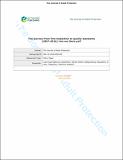Files in this item
The journey from first inspection to quality standards (1857-2016) : are we there yet?
Item metadata
| dc.contributor.author | Campbell, Martin | |
| dc.date.accessioned | 2017-06-21T11:30:07Z | |
| dc.date.available | 2017-06-21T11:30:07Z | |
| dc.date.issued | 2017-06-12 | |
| dc.identifier | 249739147 | |
| dc.identifier | 26c365e3-1bc6-4c03-91f8-ed796770b00e | |
| dc.identifier | 85021738766 | |
| dc.identifier | 000407288900003 | |
| dc.identifier.citation | Campbell , M 2017 , ' The journey from first inspection to quality standards (1857-2016) : are we there yet? ' , The Journal of Adult Protection , vol. 19 , no. 3 , pp. 117-129 . https://doi.org/10.1108/JAP-10-2016-0024 | en |
| dc.identifier.issn | 1466-8203 | |
| dc.identifier.uri | https://hdl.handle.net/10023/11040 | |
| dc.description | This research was part funded by the Carnegie Foundation in Scotland | en |
| dc.description.abstract | Purpose: This paper is a qualitative analysis of the inspection and regulation of care for people with learning disabilities and mental health problems in Scotland, in two time periods. Design/Methodology/approach: The paper uses comparative historical research, drawing on primary sources from 1857 to 1862 in the form of Annual Reports of the General Board of Commissioners in Lunacy for Scotland and associated papers, to compare inspection methods, quality standards, and to identify persistent challenges to effective inspection. Findings: Political, clinical and public awareness led initially to criticisms of existing care and eventually to the development of the “The Lunacy Act” of 1857. This Act resulted in the first attempts to set minimum standards of care for individuals at risk, with enforceable regulation. Some factors recur as challenges to effective practice in the inspection and regulation of care today Research limitations/implications: This research was part funded by the Carnegie Foundation in Scotland. Practical implications: There are problems of definition, reliable monitoring of quality standards and adequate, independent inspection of services that respond to unacceptable standards of care. There is a growing evidence base about best methods of inspection of services for people in care who are most at risk. These methods attempt to strike a balance between evidence-based and value-based judgments. Perspectives from history may help focus resources Social implications: Originality/value: This paper compares common themes and common challenges in two time periods to investigate what can be learned about the development of policy and practice in inspection and regulation of care. | |
| dc.format.extent | 273875 | |
| dc.language.iso | eng | |
| dc.relation.ispartof | The Journal of Adult Protection | en |
| dc.subject | Safeguarding | en |
| dc.subject | Inspection | en |
| dc.subject | Historical research | en |
| dc.subject | Learning/Intellectual Disabilities | en |
| dc.subject | Mental health | en |
| dc.subject | Regulation of care | en |
| dc.subject | R Medicine (General) | en |
| dc.subject | BF Psychology | en |
| dc.subject | T-NDAS | en |
| dc.subject | SDG 3 - Good Health and Well-being | en |
| dc.subject.lcc | R1 | en |
| dc.subject.lcc | BF | en |
| dc.title | The journey from first inspection to quality standards (1857-2016) : are we there yet? | en |
| dc.type | Journal article | en |
| dc.contributor.institution | University of St Andrews. School of Psychology and Neuroscience | en |
| dc.contributor.institution | University of St Andrews. Office of the Principal | en |
| dc.identifier.doi | https://doi.org/10.1108/JAP-10-2016-0024 | |
| dc.description.status | Peer reviewed | en |
| dc.date.embargoedUntil | 2017-06-12 |
This item appears in the following Collection(s)
Items in the St Andrews Research Repository are protected by copyright, with all rights reserved, unless otherwise indicated.

